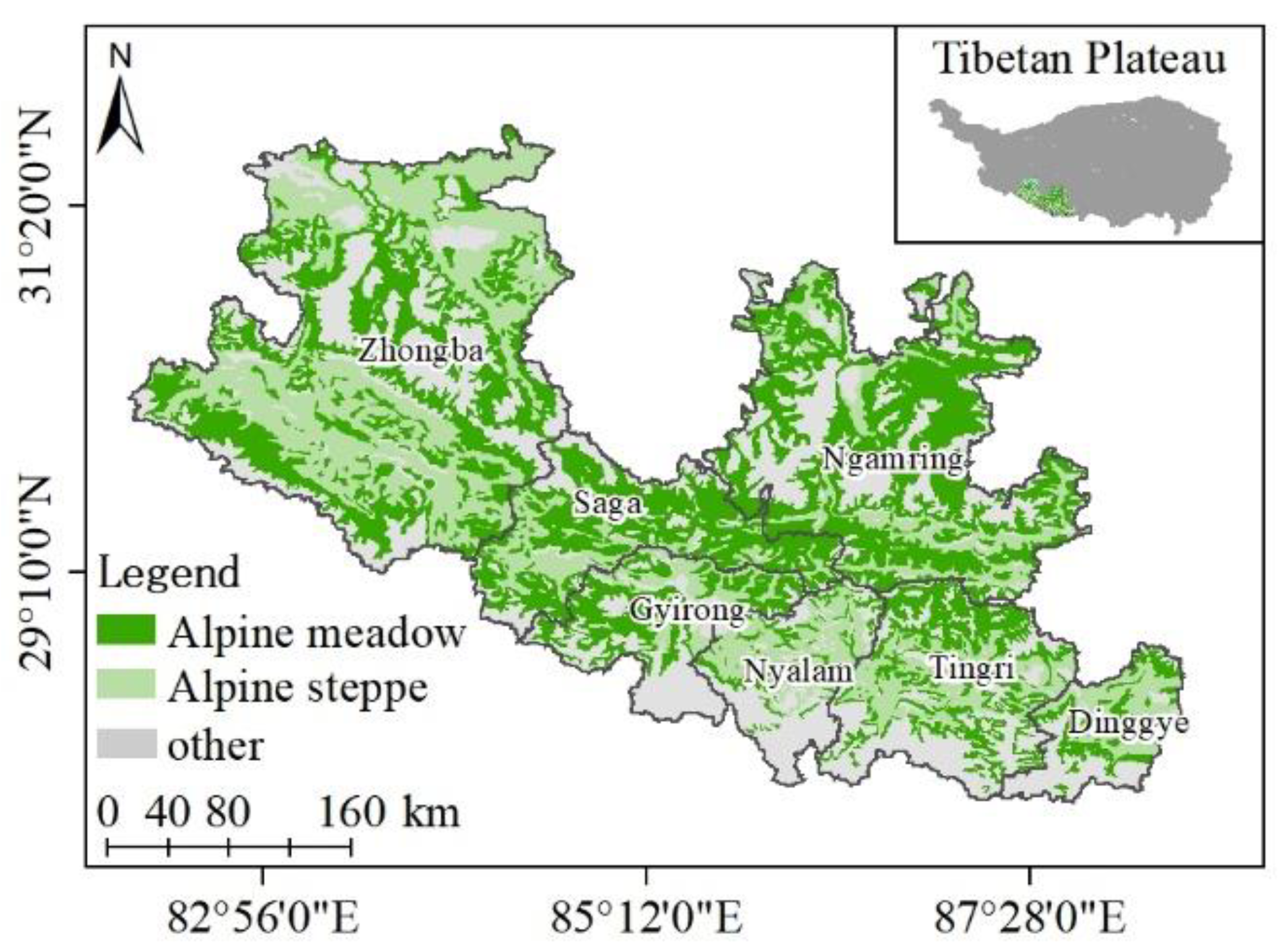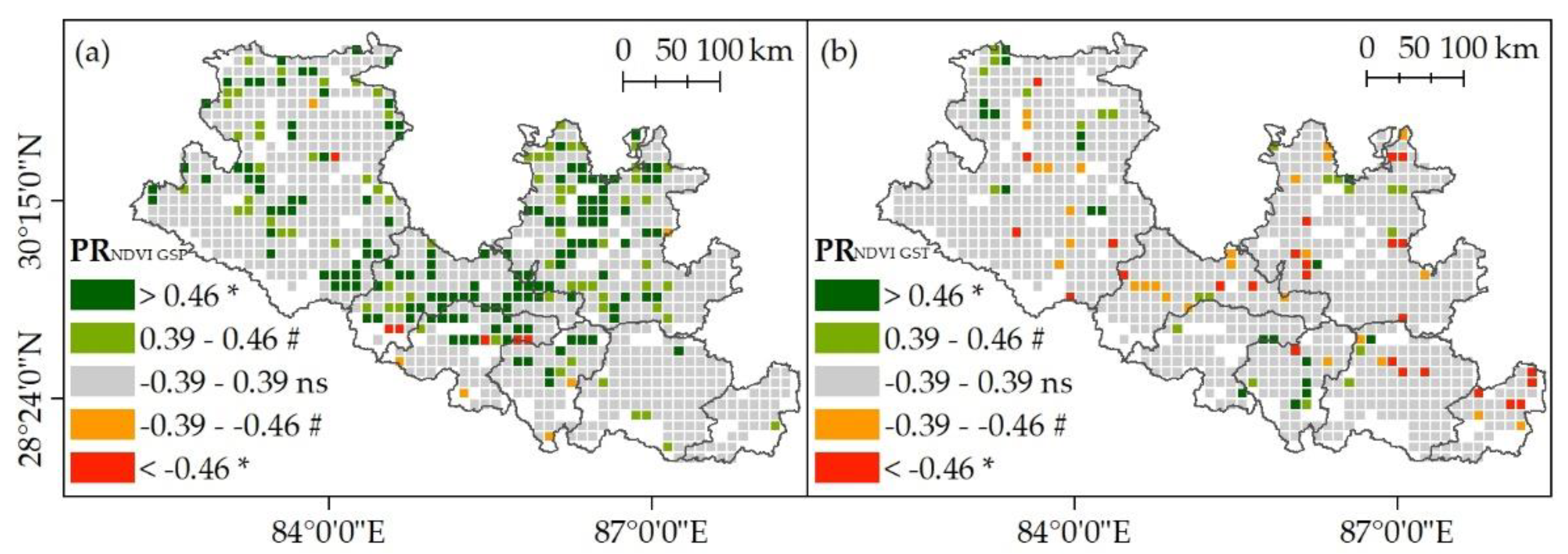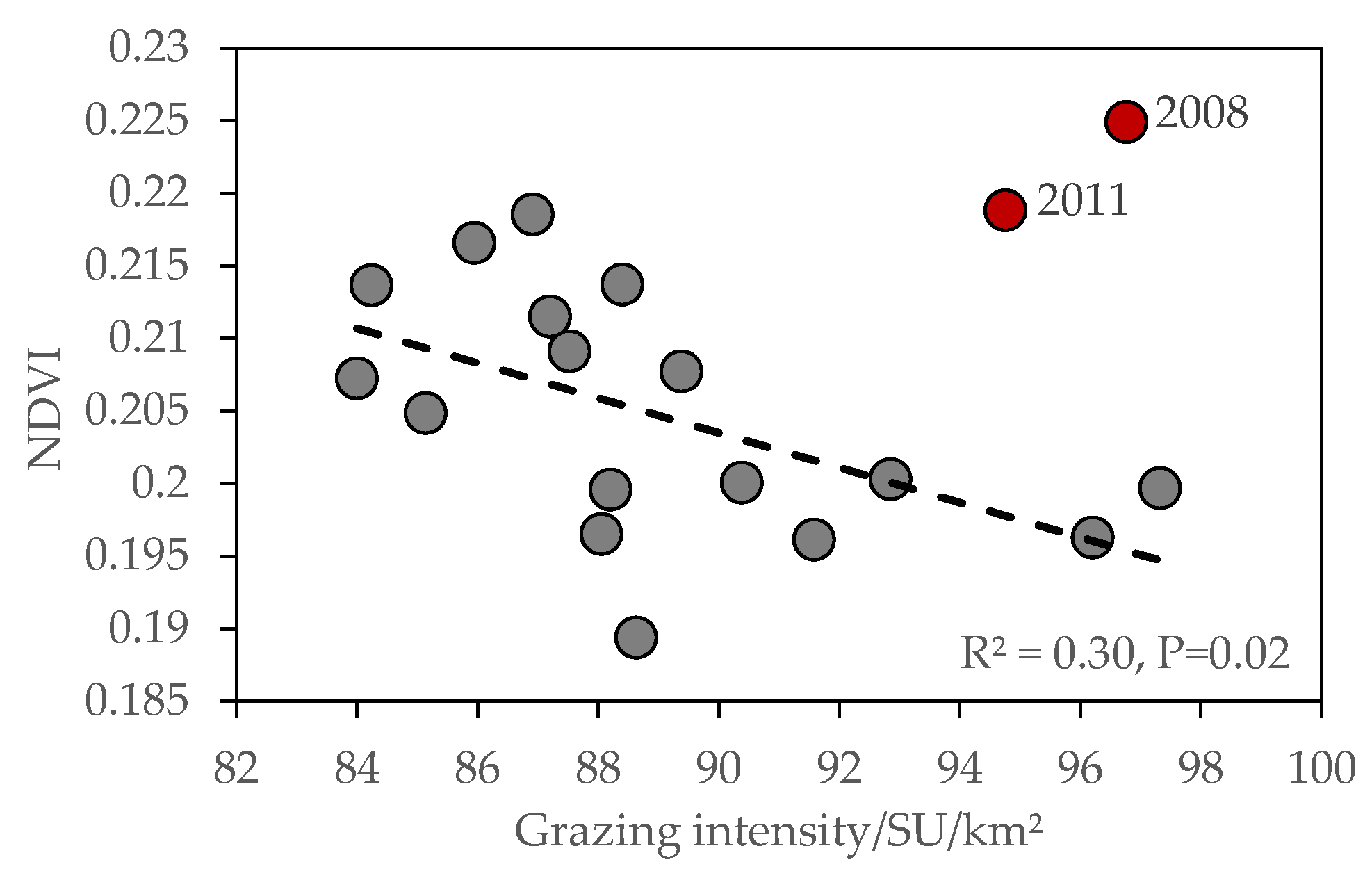Relative Impact of Climate Change and Grazing on NDVI Changes in Grassland in the Mt. Qomolangma Nature Reserve and Adjacent Regions during 2000–2018
Abstract
:1. Introduction
2. Materials and Methods
2.1. Study Area
2.2. Data Processing
2.3. Analysis of NDVI Interannual Change Trend
2.4. Correlation Analysis between NDVI and Main Influencing Factors
2.5. RESTREND Analysis
2.6. Statistical Analysis
3. Results
3.1. Interannual Variations in Grassland NDVI during 2000–2018
3.2. Variations in Climatic Factors and the Number of Livestock and Their Relationships with NDVI
3.3. Relative Effects of Climate Factors and Grazing on Grassland NDVI
4. Discussion
5. Conclusions
Author Contributions
Funding
Institutional Review Board Statement
Data Availability Statement
Acknowledgments
Conflicts of Interest
References
- Zhao, X.; Tan, K.; Zhao, S.Q.; Fang, J. Changing climate affects vegetation growth in the arid region of the Northwestern China. J. Arid Environ. 2011, 75, 946–952. [Google Scholar] [CrossRef]
- Kim, Y.; Kimball, J.S.; Zhang, K.; McDonald, K.C. Satellite detection of increasing northern hemisphere non-frozen seasons from 1979 to 2008: Implications for regional vegetation growth. Remote Sens. Environ. 2012, 121, 472–487. [Google Scholar] [CrossRef]
- Zhang, Y.L.; Gao, J.G.; Liu, L.S.; Wang, Z.F.; Ding, M.J.; Yang, X.C. NDVI-based vegetation changes and their responses to climate change from 1982 to 2011: A case study in the Koshi river basin in the middle Himalayas. Glob. Planet. Chang. 2013, 108, 139–148. [Google Scholar] [CrossRef]
- Wang, G.X.; Hu, H.C.; Wang, Y.B.; Chen, L. Response of alpine cold ecosystem biomass to climate changes in permafrost region of the Tibetan Plateau. J. Glaciol. Geocryol. 2007, 29, 671–679. (In Chinese) [Google Scholar]
- Hu, M.Q.; Mao, F.; Sun, H.; Hou, Y.Y. Study of normalized difference vegetation index variation and its correlation with climate factors in the three-river-source region. Int. J. Appl. Earth Obs. Geoinf. 2011, 13, 24–33. [Google Scholar] [CrossRef]
- Sun, J.; Cheng, G.W.; Li, W.P.; Sha, Y.K.; Yang, Y.C. On the variation of NDVI with the principal climatic elements in the Tibetan Plateau. Remote Sens. 2013, 5, 1894–1911. [Google Scholar] [CrossRef] [Green Version]
- Piao, S.L.; Liu, Z.; Wang, T.; Peng, S.S.; Ciais, P.; Huang, M.T.; Ahlstrom, A.; Burkhart, J.F.; Chevallier, F.; Janssens, I.A.; et al. Weakening temperature control on the interannual variations of spring carbon uptake across northern lands. Nat. Clim. Chang. 2017, 7, 359–363. [Google Scholar] [CrossRef]
- Wang, X.Y.; Wang, T.; Guo, H.; Liu, D.; Zhao, Y.T.; Zhang, T.T.; Liu, Q.; Piao, S.L. Disentangling the mechanisms behind winter snow impact on vegetation activity in northern ecosystems. Glob. Chang. Biol. 2018, 24, 1651–1662. [Google Scholar] [CrossRef]
- Li, R.C.; Luo, T.X.; Mölg, T.; Zhao, J.X.; Li, X.; Cui, X.Y.; Du, M.Y. Leaf unfolding of Tibetan alpine meadows captures the arrival of monsoon rainfall. Sci. Rep. 2016, 6, 20985. [Google Scholar] [CrossRef]
- Zhang, G.L.; Ouyang, H.; Zhang, X.Z.; Zhou, C.P.; Xu, X.L. Vegetation change and its responses to climatic variation based on eco-geographical region of Tibetan Plateau. Geogr. Res. 2010, 29, 2004–2016. (In Chinese) [Google Scholar]
- Sun, J.; Qin, X.J.; Yang, J. Precipitation and temperature regulate the seasonal changes of NDVI across the Tibetan Plateau. Environ. Earth Sci. 2016, 75, 291. [Google Scholar] [CrossRef]
- Zhang, L.; Guo, H.D.; Lei, J.; Lei, L.P.; Wang, C.Z.; Yan, D.M.; Li, B.; Li, J. Vegetation greenness trend (2000 to 2009) and the climate controls in the Qinghai-Tibetan Plateau. J. Appl. Remote Sens. 2013, 7, 073572. [Google Scholar] [CrossRef]
- Owensby, C.E.; Ham, J.M.; Auen, L.M. Fluxes of CO2 from grazed and ungrazed tallgrass prairie. Rangel. Ecol. Manag. 2006, 59, 111–127. [Google Scholar] [CrossRef]
- Liu, J.S.; Wang, L.; Wang, D.L.; Bonser, S.P.; Sun, F.; Zhou, Y.F.; Gao, Y.; Teng, X. Plants can benefit from herbivory: Stimulatory effects of sheep saliva on growth of Leymus chinensis. PLoS ONE 2012, 7, e29259. [Google Scholar] [CrossRef] [PubMed] [Green Version]
- Lin, Y.; Hong, M.; Han, G.D.; Zhao, M.L.; Bai, Y.F.; Chang, S. Grazing intensity affected spatial patterns of vegetation and soil fertility in a desert steppe. Agric. Ecosyst. Environ. 2010, 138, 282–292. [Google Scholar] [CrossRef]
- Zhang, X.Z.; Yang, Y.P.; Piao, S.L.; Bao, W.K.; Wang, S.P.; Sun, H.; Luo, T.X.; Zhang, Y.J.; Shi, P.L.; Liang, E.Y.; et al. Ecological change on the Tibetan Plateau. Chin. Sci. Bull. 2015, 60, 3048–3056. (In Chinese) [Google Scholar]
- Lehnert, L.W.; Wesche, K.; Trachte, K.; Reudenbach, C.; Bendix, J. Climate variability rather than overstocking causes recent large scale cover changes of Tibetan pastures. Sci. Rep. 2016, 6, 24367. [Google Scholar] [CrossRef] [Green Version]
- Pan, T.; Zou, X.T.; Liu, Y.J.; Wu, S.H.; He, G.M. Contributions of climatic and non-climatic drivers to grassland variations on the Tibetan Plateau. Ecol. Eng. 2017, 108, 307–317. [Google Scholar] [CrossRef]
- Zhong, H.X.; Liu, S.Z.; Wang, X.D.; Zhu, W.Z.; Li, X.M.; Yang, L. A Research on the protection and construction of the state ecological safe shelter zone on the Tibet Plateau. J. Mt. Sci. 2006, 24, 129–136. (In Chinese) [Google Scholar]
- Wang, X.D.; Cheng, G.W.; Zhao, T.; Zhang, X.Z.; Zhu, L.P.; Huang, L. Assessment on protection and construction of ecological safety shelter for Tibet. Bull. Chin. Acad. Sci. 2017, 32, 29–34. (In Chinese) [Google Scholar]
- Editorial Board of Vegetation Map of China, Chinese Academy of Sciences. Vegetation Atlas of China; Science Press: Beijing, China, 2001. (In Chinese) [Google Scholar]
- Tibet Department of Agriculture and Animal Husbandry. Grassland Resources and Ecological Statistics in Tibet Autonomous Region; China Agriculture Press: Beijing, China, 2017; pp. 183–200. (In Chinese) [Google Scholar]
- Wang, S.J.; Tang, X.Y.; Wang, G.; Li, Y.Q. Study on the climatic characteristics in the mount Qomolangma region during the last 53 Years. Plateau Mt. Meteorol. Res. 2021, 41, 2–6. (In Chinese) [Google Scholar]
- Zhao, W.L.; Luo, T.X.; Zhang, L. Relative impact of climate change and grazing on NDVI variations in typical alpine desert grasslands in Tibet. Acta Ecol. Sin. 2019, 39, 8494–8503. (In Chinese) [Google Scholar]
- Li, X.; Zhang, L.; Luo, T.X. Rainy season onset mainly drives the spatiotemporal variability of spring vegetation green-up across alpine dry ecosystems on the Tibetan Plateau. Sci. Rep. 2020, 10, 18797. [Google Scholar] [CrossRef] [PubMed]
- Yu, C.Q.; Zhang, Y.J.; Claus, H.; Zeng, R.; Zhang, X.Z.; Wang, J.S. Ecological and environmental issues faced by a developing Tibet. Environ. Sci. Technol. 2012, 46, 1979–1980. [Google Scholar] [CrossRef]
- Stow, D.; Daeschner, S.; Hope, A.; Douglas, D.; Petersen, A.; Myneni, R.; Zhou, L.; Oechel, W. Variability of the seasonally integrated normalized difference vegetation index across the north slope of Alaska in the 1990s. Int. J. Remote Sens. 2003, 24, 1111–1117. [Google Scholar] [CrossRef]
- Evans, J.; Geerken, R. Discrimination between climate and human-induced dryland degradation. J. Arid Environ. 2004, 57, 535–554. [Google Scholar] [CrossRef]
- Wessels, K.J.; Prince, S.D.; Malherbe, J.; Small, J.; Frost, P.E.; VanZyl, D. Can human-induced land degradation be distinguished from the effects of rainfall variability? A case study in South Africa. J. Arid Environ. 2007, 68, 271–297. [Google Scholar] [CrossRef]
- Li, A.; Wu, J.G.; Huang, J.H. Distinguishing between human-induced and climate-driven vegetation changes: A critical application of RESTREND in inner Mongolia. Landsc. Ecol. 2012, 27, 969–982. [Google Scholar] [CrossRef]
- Burrell, A.L.; Evans, J.P.; Liu, Y. The addition of temperature to the TSS-RESTREND methodology significantly improves the detection of dryland degradation. IEEE J. Sel. Top. Appl. Earth Obs. Remote Sens. 2019, 12, 2342–2348. [Google Scholar] [CrossRef]
- Cai, H.Y.; Yang, X.H.; Xu, X.L. Human-induced grassland degradation/restoration in the central Tibetan Plateau: The effects of ecological protection and restoration projects. Ecol. Eng. 2015, 83, 112–119. [Google Scholar] [CrossRef]
- Zhang, R.P.; Liang, T.G.; Guo, J.; Xie, H.J.; Feng, Q.S.; Aimaiti, Y. Grassland dynamics in response to climate change and human activities in Xinjiang from 2000 to 2014. Sci. Rep. 2018, 8, 2888. [Google Scholar] [CrossRef]
- Li, P.L.; Hu, Z.M.; Liu, Y.W. Shift in the trend of browning in Southwestern Tibetan Plateau in the past two decades. Agric. For. Meteorol. 2020, 287, 1–9. [Google Scholar] [CrossRef]
- He, K.D.; Sun, J.; Chen, Q.J. Response of climate and soil texture to net primary productivity and precipitation-use efficiency in the Tibetan Plateau. Pratacultural Sci. 2019, 36, 1053–1065. (In Chinese) [Google Scholar]
- Yan, L.; Zhou, G.S.; Zhang, F. Effects of different grazing intensities on grassland production in China: A meta-analysis. PLoS ONE 2013, 8, e81466. [Google Scholar] [CrossRef] [PubMed]
- Li, G.; Sun, W.L.; Zhang, H.; Gao, C.Y. Balance between actual number of livestock and livestock carrying capacity of grassland after added forage of straw based on remote sensing in Tibetan Plateau. Trans. Chin. Soc. Agric. Eng. 2014, 30, 200–211. (In Chinese) [Google Scholar]
- Zhao, J.G.; Liu, C.Q.; Li, H.B.; Luo, N.; Meng, S.J.; Zhang, Z.H.; Wang, J.H. Effects of main climatic factors on plant community characteristics of a meadow steppe under different grazing intensities. J. Landsc. Res. 2019, 11, 108–110. [Google Scholar]
- Wang, Y.J.; Fu, B.J.; Liu, Y.X.; Li, Y.; Feng, X.M.; Wang, S. Response of vegetation to drought in the Tibetan Plateau: Elevation differentiation and the dominant factors. Agricult. Forest Meteorol. 2021, 306, 108468. [Google Scholar] [CrossRef]
- Ding, J.Z.; Yang, T.; Zhao, Y.T.; Liu, D.; Wang, X.Y.; Yao, Y.T.; Peng, S.S.; Wang, T.; Piao, S.L. Increasingly important role of atmospheric aridity on Tibetan alpine grasslands. Geophys. Res. Lett. 2018, 45, 2852–2859. [Google Scholar] [CrossRef]
- Liu, R.; Li, Y.; Liu, Y. Responses of CO2 flux in a saline desert of Northwest China to two contrasting extreme precipitation years. Chin. J. Ecol. 2013, 32, 2545–2551. (In Chinese) [Google Scholar]
- Liu, D.; Wang, T.; Yang, T.; Yan, Z.J.; Liu, Y.W.; Zhao, Y.T.; Piao, S.L. Deciphering impacts of climate extremes on Tibetan grasslands in the last fifteen years. Sci. Bull. 2019, 64, 446–454. [Google Scholar] [CrossRef] [Green Version]









| Scenario | SlopeNDVIA | SlopeNDVIP | SlopeNDVIH | Description |
|---|---|---|---|---|
| 1 | + | − | − | Human activity contributes to grassland NDVIA increase |
| 2 | + | + | − | Both climate change and human activity contribute to NDVIA increase |
| 3 | + | + | + | Climate change contributes to grassland NDVIA increase |
| 4 | − | + | + | Human activity contributes to grassland NDVIA decrease |
| 5 | − | − | + | Both climate change and human activity contribute to NDVIA decrease |
| 6 | − | − | − | Climate change contributes to grassland NDVIA decrease |
Publisher’s Note: MDPI stays neutral with regard to jurisdictional claims in published maps and institutional affiliations. |
© 2022 by the authors. Licensee MDPI, Basel, Switzerland. This article is an open access article distributed under the terms and conditions of the Creative Commons Attribution (CC BY) license (https://creativecommons.org/licenses/by/4.0/).
Share and Cite
Zhao, W.; Luo, T.; Wei, H.; Alamu; Zhang, L. Relative Impact of Climate Change and Grazing on NDVI Changes in Grassland in the Mt. Qomolangma Nature Reserve and Adjacent Regions during 2000–2018. Diversity 2022, 14, 171. https://doi.org/10.3390/d14030171
Zhao W, Luo T, Wei H, Alamu, Zhang L. Relative Impact of Climate Change and Grazing on NDVI Changes in Grassland in the Mt. Qomolangma Nature Reserve and Adjacent Regions during 2000–2018. Diversity. 2022; 14(3):171. https://doi.org/10.3390/d14030171
Chicago/Turabian StyleZhao, Wanglin, Tianxiang Luo, Haijuan Wei, Alamu, and Lin Zhang. 2022. "Relative Impact of Climate Change and Grazing on NDVI Changes in Grassland in the Mt. Qomolangma Nature Reserve and Adjacent Regions during 2000–2018" Diversity 14, no. 3: 171. https://doi.org/10.3390/d14030171
APA StyleZhao, W., Luo, T., Wei, H., Alamu, & Zhang, L. (2022). Relative Impact of Climate Change and Grazing on NDVI Changes in Grassland in the Mt. Qomolangma Nature Reserve and Adjacent Regions during 2000–2018. Diversity, 14(3), 171. https://doi.org/10.3390/d14030171







